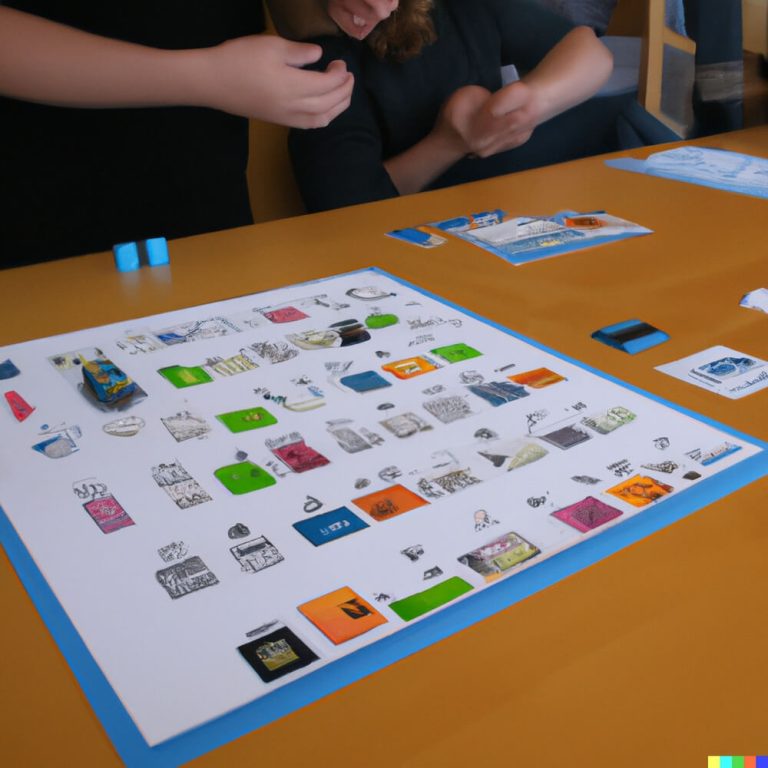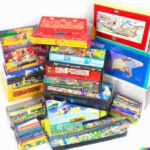Introduction
In recent years, there has been a growing interest among people of all ages in playing board games. This influx of passionate players is credited to the emergence of more casual gaming options, which have made games accessible to even more people. These developments can be seen across all genres, from classic favorites like Monopoly and Clue to new strategy titles such as Scythe, Arkham Horror, and Gloomhaven. Even the concept of the game night has changed, with many gamers opting for board games over other forms of entertainment due to their ease of play and social component.
This renewed enthusiasm for board games has caused a resurgence in their popularity and sparked an immense amount of creativity when it comes to product design. Manufacturers now produce boards and dice that are as intricate as works of art. Beyond visual presentation, game creators have been busy creating rulesets that are simple yet provide tremendous depth. This balance appeals to both casual players who want a fun way to spend time with friends or family members, as well as advanced gamers who seek out complex challenges with potentially infinite outcomes. And those looking for maximum flexibility can often find solo variants or multiple expansions that add plenty of replay value. All these elements come together to make a single board game experience that’s captivating and exciting regardless of player skill level or experience level. As a result, there’s something for everyone when it comes to playing board games right now”from classic card-based party options for large groups down to thoughtful solitaire puzzles enjoyed by one person at a time.
Outlining the Advantages of Playing Board Games
Board games come with a range of advantages, providing fun, entertaining and educational experiences. Board games have the power to bring people together and create meaningful connections as players work together to solve puzzles and strategize. Playing board games also encourages social interaction as players share stories, learn, experience joy and excitement while having fun. Additionally, board games can increase mental sharpness and alertness since they require players to think critically in order to win or complete tasks. They can also help increase children’s focus by teaching them valuable lessons about cause and effect relationships, problem-solving, how to take turns and what it means to lose graciously. Board games help build fine motor skills for younger players such as picking up various pieces or rolling dice. Further, studies have found that playing board games can reduce stress levels by challenging our minds without overloading them easily overwhelmed by technology. Finally, board games are incredibly portable making them a great option for taking on trips and vacations where boredom might set in!
Investigating the Different Categories of Board Games
Board games come in many different varieties, but all contribute to creating a unique and enjoyable experience. From strategy and co-operative games, to trivia and skill based activities, new board games can be found for virtually any preference. Strategy board games involve lots of decisions and planning, as each decision affects the outcome of the game. These are best for those who like to challenge their problem-solving skills. For those looking for something lighthearted yet competitive, trivia and party board games provide a lot of entertainment. In trivia games players must match wits against each other while answering questions on a wide range of topics such as music or sports knowledge. Co-operative board games require cooperation between players in order to win the game; these are ideal for families or friends looking to work together. Skill based activities help children practice different skills such as counting or following directions in a fun way that encourages teamwork among young players. Many modern board games also contain elements of multiple categories, so there is truly something out there that anyone can enjoy playing.
Examining How Board Games Have Evolved Over Time
Board games have long been a popular form of entertainment, but what began as simple affairs have evolved into much more complex experiences over the past century. From the very basic checker and chess boards of yesteryear to the immersive stories told through tabletop RPGs, board games now cover many different areas of interest. In addition to playing pieces, boards and rulebooks, many games now include detailed miniatures, cards and dice that give players opportunities to build their own customised armies or take on a variety of tasks as they navigate a narrative. Even classic favourites such as Monopoly and Clue have seen updates to bring them more in line with modern tastes and designs.
As board game culture continues to surge in popularity, game developers are offering increasingly innovative products. Many popular titles focus on story-driven experiences that involve developing characters while exploring dungeons, gathering resources, fending off monsters or racing opponents. Board game mechanics like programmed movement, role-playing elements and ever-changing objectives keep players engaged deep into every adventure. There are even team-building exercises available now that utilise miniatures for scouting objectives or competing against live opponents in real time via apps. With so much variety out there truly something for everyone when it comes to board games nowadays!
Analyzing the Popularity of Board Games on Streaming Platforms
In recent years, the popularity of board games have been on the rise. This particular trend can be seen on streaming platforms. Through audience viewership and engagement metrics, streaming platforms can accurately measure which types of board games are popular with current audiences. Furthermore, they are able to identify which type of board game appeals to different demographics and locales. As a result, streaming platforms provide deep insights into what kind of board games people want to play.
The popularity of many traditional or classic board games such as chess and checkers still remain high across all streaming platforms, but other types of new, modernised versions or versions tailored for a specific audience have become increasingly popular too. For example, role-playing and fantasy dice-based board games are very popular amongst a younger demographic due to their stories and characters that the players can interact with during gameplay – such as Dungeons & Dragons. In comparison older audiences tend to enjoy strategic themed games such as Settlers of Catan where they must make wise trading decisions while vying for control over the game’s resources. Not only this but through Big Data analytics streaming platforms are harnessing data from individual player profiles to modify existing rules or features within certain games in order to enhance game-time experiences catered specifically towards individual players.
Identifying Trends in Classic and Modern Board Games
In recent years, there has been a shift away from classic board games to more modern and interactive ones. This is due to a number of factors such as the rise of technology, changes in consumer tastes, and an increased preference for greater complexity in gaming experiences. Companies have responded to this trend by releasing new board game iterations that often feature innovative features such as app-level game play and solo modes. These games also often include complex storylines, interesting world-building elements, and unexpected narrative elements that keep players engaged. Additionally, due to their interactive nature, these new board games are more social than ever before and have fostered an exciting gaming community made up of passionate enthusiasts who actively seek out new releases and challenge themselves to expand their knowledge of different genres. Ultimately, this shift in trends has allowed for increased competition among companies developing new board game titles that blur the lines between traditional tabletop gamers and digital adventurers.
Showcasing Creative Ideas for Board Game Designers
New board games allow for people of all ages to come together and engage in different forms of entertainment that foster creativity, strategy, and problem-solving. Board game designers are exploring a wide range of topics, from classic adventures and fantasy worlds to science fiction and more. As board gaming continues to grow in popularity, so do the creative possibilities for new board game designs.
In recent years, board game designers have been using innovative ideas to create captivating storylines and themes that draw players in. From post-apocalyptic scenarios to abstract tile based puzzles, new themes provide fresh opportunities for strategic thought throughout each game. Additionally, interactive components such as apps or companion websites allow players to craft their own experiences as they progress through a game by unlocking special content or hints throughout playtime. Unique objectives like cooperative story telling or unique scoring mechanisms create unique ways of playing popular genres like roll-and-write games and worker placement style games plus introduce exciting mechanics unlike anything seen before. Lastly, the production quality of many new releases has evolved significantly with high-quality art pieces accompanying stylish components that give off an air of elegance upon touching the box lid! With accessibly priced titles now instantly available on platforms exposing indie productions at warp speed, there is no shortage of imaginative ideas for game designers to explore and new board games debuting now and in the future!
Comparative Analysis
One of the most popular board games in recent years is Settlers of Catan, sometimes referred to simply as Catan. In the game, players compete to gather resources and build settlements by following dictates found on hexagonal tiles scattered across their game board. Trade and negotiation between opponents is essential for success.
Another classic recently making a resurgence is Monopoly. It’s similar in some ways to Catan; however, it differs in many respects. Money is the principal medium of exchange, while opportunity cards and dice rolls move players around the gameboard. Instead of an intricate resource-gathering system like Catan employs, Monopoly relies primarily upon chance and luck. Players often must pay rent to another player if their piece lands on another’s property, creating a cutthroat economic atmosphere far different from Catan’s cooperative trading atmosphere.
Settlers of Catan offers a much more complicated array of decision-making tools than Monopoly and allows players to engage in diplomatic relations negotiated through bartering resources with each other instead of engaging in competition or combat favored by creators of traditional dice rolling games like Monopoly. With its vibrant mix of strategy and risk, plus its need for collaboration between opponents, it’s clear why so many people have been drawn to Catan ” making it one of the highest grossing board games since its release 25 years ago!
On the other hand, there are many who still enjoy playing Monopoly due to its straightforward ruleset with little complexity involved compared to many more modern board games. Despite being an older title that has been around since 1935 it still remains incredibly popular compared to titles released within recent years and appeals primarily towards those who aren’t as interested in investing large amounts of time into learning complex yet exciting new mechanics featured heavily in modern board games such as Settlers of Catan.
Community Building with Board Games
Board games can provide a great way to create community and foster social interaction among members of all ages. Although board games have been around for centuries, there are now countless new options to choose from and cater to any crowd. For example, cooperative board games that require players to work together as a team. So how can you get the most out of these new fun-filled activities?
When using board games as a social activity, it’s important to remember that everyone’s experience should be one of enjoyment. It’s best to set expectations ahead of time by clearly communicating the rules, level of difficulty, and objective of the game. It is also useful to remind players that winning isn’t necessary and valuable moments will be shared during group conversations regardless of who wins or loses.
One strategy for creating an engaging atmosphere is assigning roles within the group. This will allow people with particular skills to shine, creating collaboration between participants even though they may be playing the same game together. To assist with this process, grant players different steps in setup or individual turns taking various roles in order to give everyone a chance at leading the game.
Another tip for putting an exciting spin on each game is including additional content like music or specific snacks into the setting so that everyone can associate strong positive emotions with enjoying board games together as a whole. Invite others nearby for additional support if needed and round off each session with meaningful conversations about what each player took away from their experience with different strategies used throughout!
Concluding the Blog Post
Board games provide an excellent opportunity to bring people together in a way that is fun, exciting and educational. As the popularity of board games rises, so too do the variety of options available. Today, you can find anything from two-player quick-play experiences to long campaigns with many different characters and storylines. With all these new possibilities makes it important to ensure that gameplay is still accessible for everyone. Here are some tips for making board games more fun and accessible:
1. Have clear instructions: Explain the rules in an easy-to-understand way, taking time to go over each step without leaving out any important points. Make sure your directions reference any potential common questions or mistakes beforehand.
2. Include variations: Offer suggestions on how players can change up their game to make it unique and more enjoyable for them each time they play. This could be ways to speed up slow parts or bonus rules that let players take special turns or rewards if they complete certain tasks during their playthroughs.
3. Introduce game modifications: Make it easier for those who may find a game too challenging by introducing modifications such as lowering the difficulty level or making pieces slightly bigger or easier to handle so they’re easier to pick up and play with during game sessions. It’s also helpful to create additional components like maps and character cards when they’re needed in order to show how specific actions interact with others on the table top.
Overall, board games provide a great opportunity for story telling and strategy which require no screen time whatsoever! By focusing on making board games open and inclusive, everyone can benefit from the power of engaging in meaningful conversations while playing together. Therefore, it’s essential to continue finding ways of tackling challenges related to accessibility by putting alternatives into practice so everyone can participate at ease in this timeless form of entertainment!

I love playing all kinds of games – from classics like Monopoly to modern favourites like Ticket to Ride.
I created this blog as a way to share my love of board games with others, and provide information on the latest releases and news in the industry.





